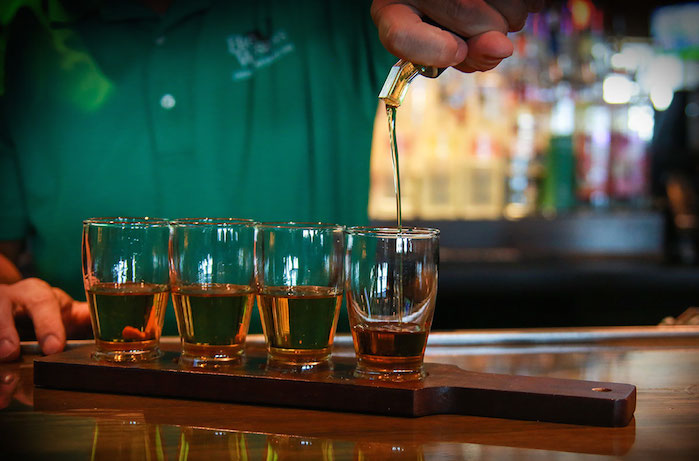Editor’s Note: to keep retailers updated about bars and restaurants, where alcohol trends typically begin, we occasionally cross-post from our on-premise magazine Cheers.
There’s no question that American whiskey is a big trend right now. “It has become—and will remain—expected that consumers can walk into any bar and have a wide selection of whiskeys and craft whiskey cocktails to choose from, the way craft beer selections are expected,” says Sarah Geist, general manager of Barrel + Rye in Geneva, IL. About 150 of the restaurant’s 200 whiskeys are American, priced from $8 to $80 for a 1 ½-oz. pour.
1) Problems with Availability
Consumer thirst for bourbon and other American whiskey styles has operational ramifications for bar and restaurant owners. While stocking backbars with sought-after bottles, many wonder how long this surge of growth can last.
Some producers were also surprised by the demand and are playing catch-up, but making good whiskey takes time. A few brands have decided to omit age statements from labels, which allows them to blend variously aged stocks.
Indeed, allocation is tight for many popular labels, making procurement tricky and expensive: Are those cult bottles worth the price?
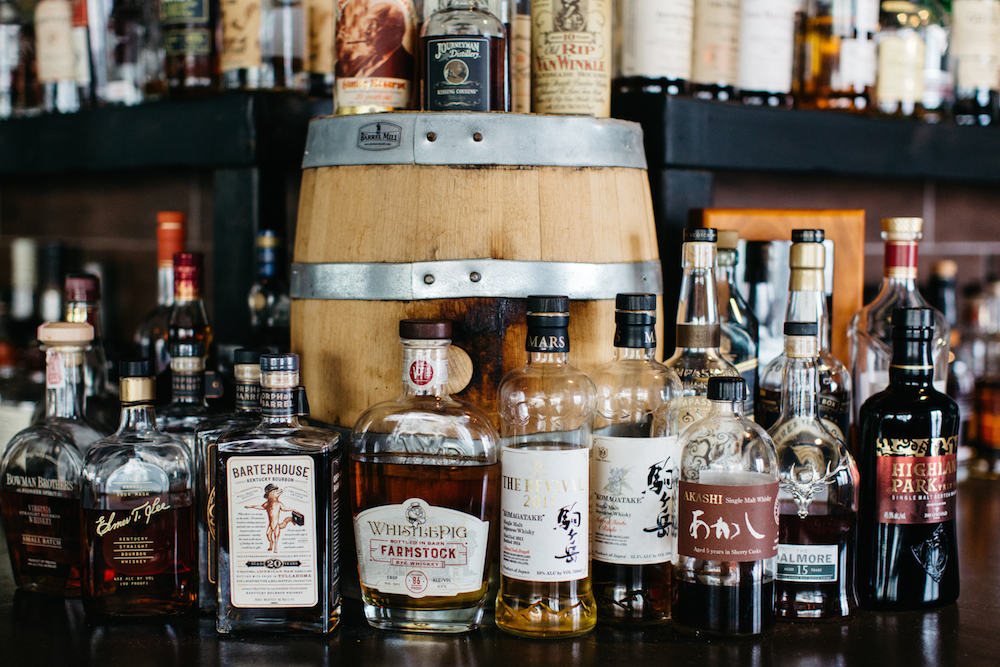
“No one saw the extent of this brown spirits explosion coming. By dropping age statements and heavy allocation, the big distilleries have managed to keep most of their labels in bars and stores,” says Brian Bolter, owner/beverage director of Dry 85: Bourbon, Beer, Provisions in Annapolis, MD.
“It drives whiskey geeks and beverage buyers crazy, but that’s the new normal,” he notes. And because so many whiskeys—even common brands—go out of stock, “it means menu changes—a lot of menu changes.” Dry 85’s curated, rotating list encompasses 150 American whiskeys, priced from $6 up to $200 for a generous 2-oz. pour.
“Brands such as Buffalo Trace, Angels Envy and Michter’s Sour Mash are now allocated versus just being able to order them by the case any given week,” says Geist at Barrel + Rye. Customers are buying top-shelf. Priced $80 a pour, Pappy Van Winkle 23-year has sold out, replaced by a 20-year-old for $60—and that’s disappearing too.
“Limited availability does not always mean better. The same goes for aged whiskey; older is not always better,” points out Hani Gabr, beverage manager at Village Whiskey in Philadelphia, part of the Garces Group Restaurants. Village Whiskey offers more than 100 American whiskeys in 1-oz. or 2-oz. pours, priced $5 to $40 per ounce. “More savvy and younger drinkers want more bang for their buck and they tend to shy away from cult whiskey because of the price,” he says.
At Big Whiskey’s American Restaurant & Bar, bartenders free-pour a 1 ¼-oz. shot, which sells for $4.50 to $35. The Springfield, MO-based, eight-unit chain offers some top-shelf contenders like Pappy Van Winkle, Blanton’s and the Sazerac family. Says Matt Caetano, vice president of training and operations, “We don’t sell a ton of the high-end, but it’s nice to be able to offer it to customers.”
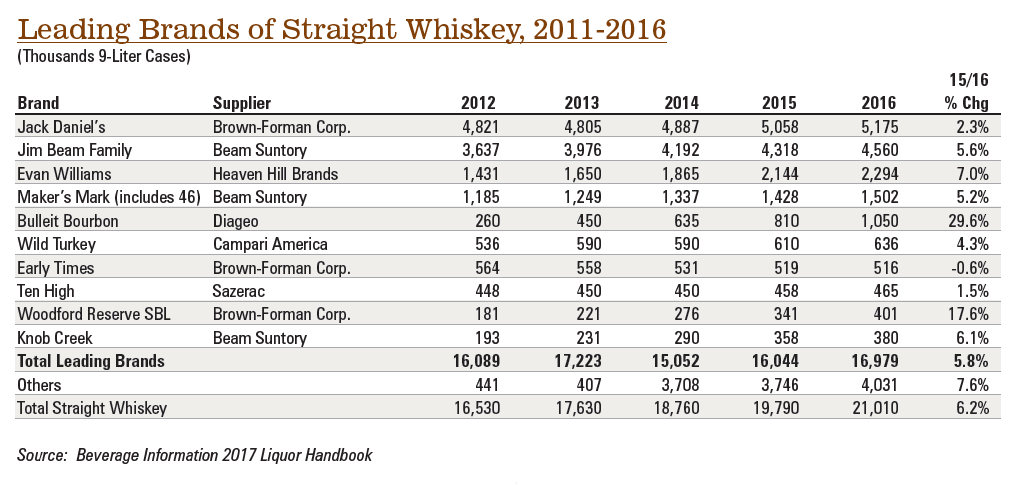
When Chae Yi opened District Distilling Co. in August 2016, he realized the importance of offering whiskey on his beverage list. Washington, DC-based District Distilling Co. is a combination working distillery and bar and restaurant. While his own liquid matures in barrels on site, Yi launched a whiskey-blending program: He buys, blends and bottles whiskeys on the premises.
Now District Distilling’s Backroom bourbon, Backroom rye and C&O Tradesman cask-finished whiskeys join WildJune Western Style gin and Corridor rye vodka on the backbar. These latter are distilled in-house and the theatrics of the distilling process is built into the concept: Designers cut a hole in the floor of the bar upstairs to expose the columns of the still, according to Yi.
2) Rye is Rising
Bourbon continues to be big, but spicy whiskeys made with a high percentage of rye in the mash bill are rapidly gaining enthusiasts. Among its five flight variations, Big Whiskey’s offers a To Rye Or Not To Rye tasting focusing on that spirit.
“Rye is the hottest thing right now,” says Village Whiskey’s Gabr. “I feel that rye–especially in cocktails—gives a little extra dimension you don’t often find in bourbon.” One of the featured flights is three local ryes from Pennsylvania. Cask-strength bourbons are also popular at Village Whiskey right now.
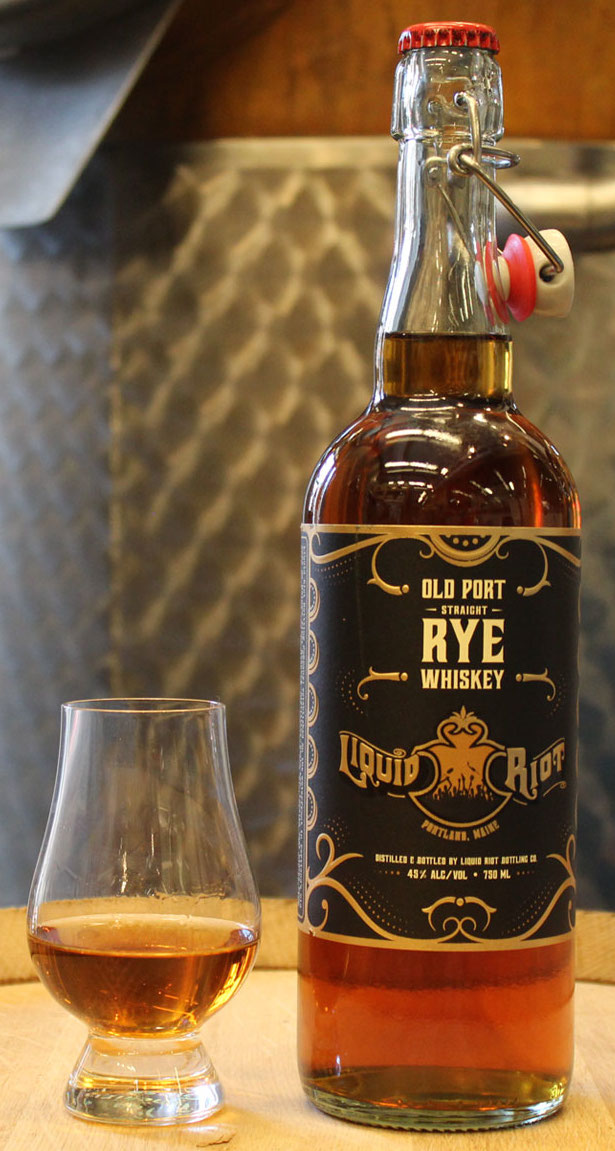
“Bourbon is hip, but rye is right behind,” says Eric Michaud, founder/owner of Liquid Riot Bottling Co., a bar and restaurant as well as a working distillery and brewery in Portland, ME. Liquid Riot’s Old Port Straight rye is mashed from organic grain grown in Maine and a bit of chocolate malt, then distilled and aged in white oak barrels right on the premises.
“More people are starting to ask for ryes than when Barrel + Rye opened three years ago, therefore we have expanded our selection a bit,” says Geist. She notes that there is also increased demand for craft spirits from local distilleries, especially as the producers gain expertise.
To stand out, some operators are showcasing a private bottling from a barrel selected right from the rickhouse. Dry 85 offers six private-barrel selections, and also partners with local craft breweries to age beer in those whiskey barrels. These one-of-a-kind, exclusive, barrel-aged beers are only available at Dry 85. It currently has five beers resting in whiskey barrels, Bolter says.
Liquid Riot makes and sells bierschnapps, which technically speaking, is not whiskey but rather a spirit distilled from beer and matured in whiskey barrels.
“The Feds won’t let us call it whiskey,” says Michaud. But he figured it was a great way to show off the full range of Liquid Riot. Bierschnapps is on the list alongside five house-made and matured whiskeys, including an unusual Old Port Oat Whiskey.
3) Flavored Whiskey as a Gateway
Many whiskey geeks and a few operators consider flavored whiskeys to be anathema. Others see flavored whiskey as a gateway for novices to discover the full-flavored world of straight whiskey. Still others want to offer drinks their customers want and ask for.
As a rule, Village Whiskey doesn’t offer any flavored versions. Dry 85 has Fireball on tap: “That’s it, and all there will ever be,” insists Bolter.
Barrel + Rye maintains a small selection of flavored whiskeys, but they do not sell too often, according to Geist. “Some customers ask if we can come up with a cocktail to use a flavored whiskey in, and some of the flavored moonshines are nice as shots.”
One of Big Whiskey’s flights is devoted to flavored. “For many people it’s an easier thing to try than a bourbon or rye flight,” says Caetano. The chain’s Whiskey Blackberry Sour cocktail combines Bird Dog blackberry whiskey with sweet-and-sour mix.
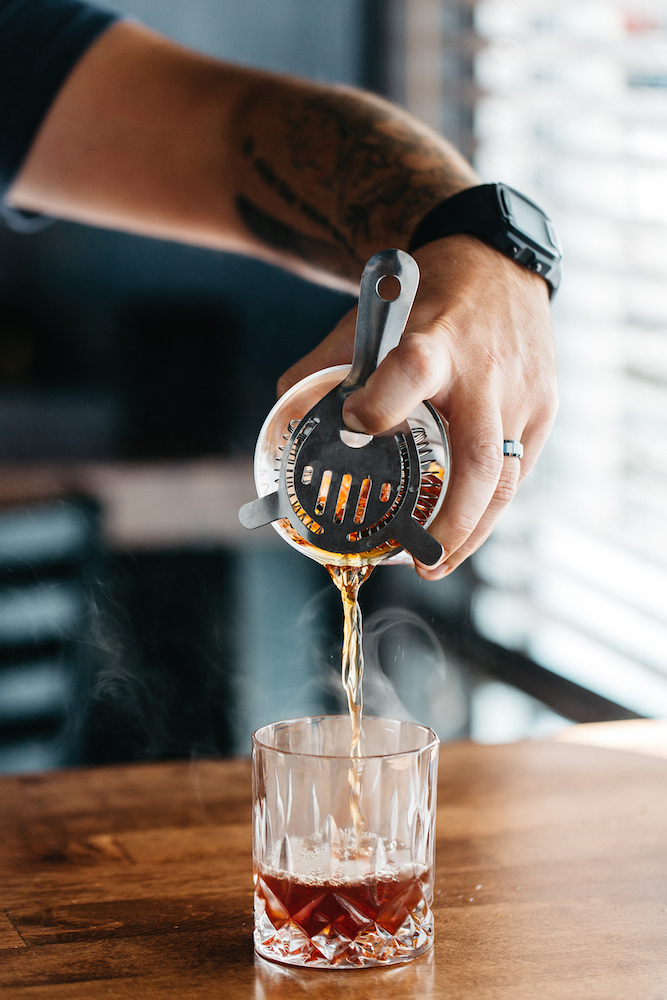
4) Whiskey Cocktails
“Our focus at Big Whiskey’s is to make the spirit more approachable for non-whiskey drinkers,” Caetano says. “Cocktails are a way to get the palate going, and cultivate people into drinking whiskey neat.”
Most of the chain’s beverage sales are from cocktails, which are priced at about $7. A popular option, the Southern Peach, is made with Southern Comfort and peach schnapps.
Playing off the trendy vodka-based Moscow Mule are the Tennessee Mule, substituting George Dickel rye, and the Kentucky Mule with Wild Turkey. These are served in Mason jars, which servers shake up tableside. That bit of dining-room theater generates me-too sales.
Big Whiskey’s was one of the first to offer whiskey on tap, says Caetano. Three taps currently dispense Big Whiskey’s private label bourbon, Buffalo Trace and Wild Turkey, priced $6 to $8 a pour. Whenever a bartender makes an Old Fashioned using the tap whiskey, it generates a lot of curiosity.
A signature cocktail at Village Whiskey is the South Broad, made with Old Overholt rye, Strega, Lillet Rose, raspberry syrup and lemon juice, shaken with egg white ($12).
While Liquid Riot offers a full bar, with a selection of spirits, wine and house-brewed beer, most guests want cocktails, says Michaud. The number-one seller is the Haute Fashioned, made with house-distilled, barrel-aged Old Port bourbon, cinnamon syrup and bitters ($13).
Other whiskey drinks include the G’Day, Old Port single malt whiskey, Pimm’s, Meletti amaro and Root liqueur ($12), and It’s Mint To Be, made with Old Port-aged oat whiskey, Chartreuse, mint and lemon juice ($12). The curious and connoisseur can also order tastes of all the spirits in ½- oz. and 2-oz. pours. Guests will often pair these with a pint of house-made beer as a custom boilermaker.
Dry 85 offers a seasonal cocktail menu, with drinks priced at about $12. “One drink that we don’t dare take off for fear of guest retribution is our Lavender Fields of Kentucky,” says Bolter. “It did fine, and then one day we substituted in Knob Creek 120 Proof and it became our best seller.” Besides the bourbon, cocktail includes house lavender-vanilla-bean syrup and fresh lime juice topped with ginger ale.
“We have a great relationship with Buffalo Trace and are using their bourbon in our Buffalo Trace Summer Sunset,” Bolter says. The mix: Buffalo Trace bourbon, freshly squeezed lime, house-made ginger syrup, Amaro di Angostura, Angostura bitters and house-smoked tincture.
At Barrel + Rye, “We like to play with unique flavors and keep coming up with new ways to get non-whiskey drinkers and whiskey drinkers alike to enjoy a new experience,” says Geist. One experience at Barrel + Rye is the Cedar Smoked Manhattan, with Bulleit bourbon, Carpano vermouth and Angostura bitters, which gets another layer of flavor from a smoldering cedar plank.
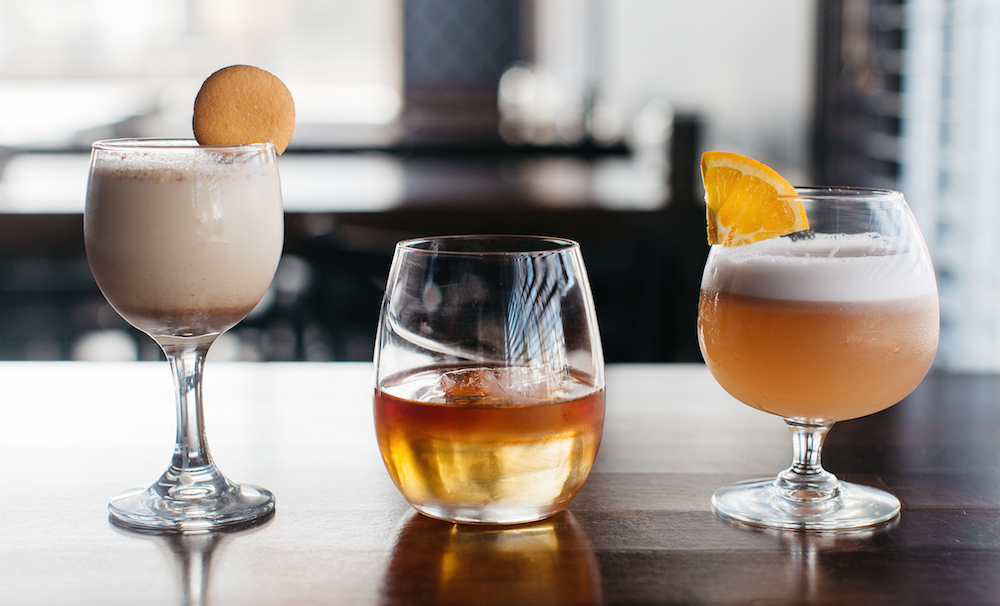
The Campfire Mole Old Fashioned is a fun fall drink made with Old Forester bourbon, a scoop of Mexican mole and mole bitters, shaken with egg white and garnished with a singed marshmallow. The Buckaroo is a riff on the classic Jack & Coke—Jack Daniel’s paired with house-made cola. A big hit on the summer menu is the Sacred Sage, a refreshing mix of blackberries, sage and Buffalo Trace bourbon. Cocktails are priced at $10.
“Whiskey is top dog at our bar,” says Yi of District Distilling. Bourbon is the best-selling liquor and the Old Fashioned is the best-selling drink.
Popular cocktails popular include the Lorelei, made with Backroom bourbon, Electra muscat, blackberry liqueur and lemon juice, garnished with blackberries and an orchid flower ($16).
The Not So Old Fashioned is a variation mixing Backroom bourbon, lavender-infused syrup, lavender bitters, orange bitters and blood orange ($15).
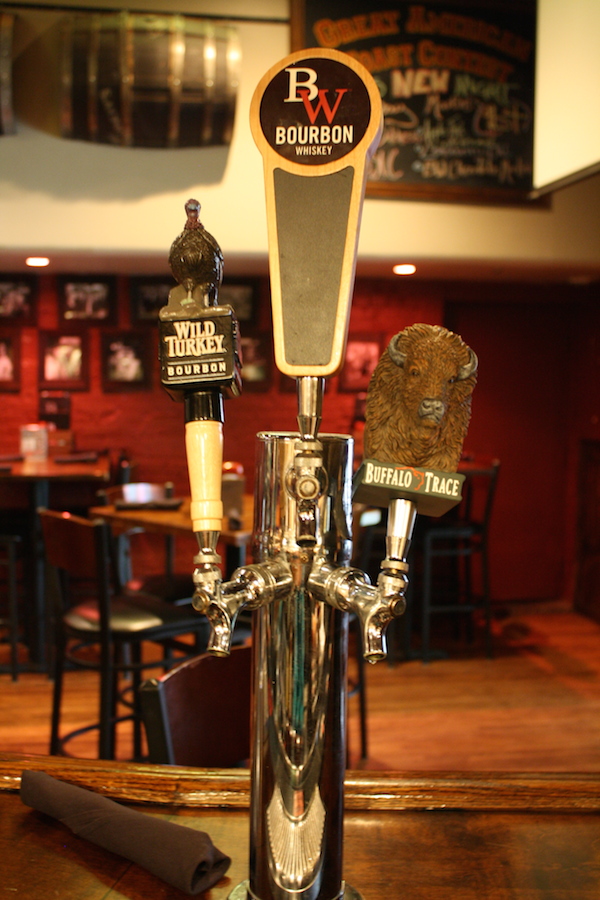
On draft at District Distilling are several batched punch drinks. The Rye-Ght Wing combines Backroom Rye, Fernet Branca, St. Germain liqueur. It’s available in a variety of portions: a 1 ½-oz. shot for $10 and an 8-oz. carafe for $55; as a punch with lemon juice, mint syrup and a locally produced cider, it’s $70.
5) Whiskey in Food
Whiskey is not only popular at the bar, it’s showing up on food menus too. “Our bourbon barbecue sauce for wings is out of this world,” boasts Brian Bolter, owner/beverage director of Dry 85: Bourbon, Beer, Provisions in Annapolis, MD.
“We try to use some of our spirits or beer in every dish,” says Eric Michaud, founder/owner of Portland, ME-based Liquid Riot Bottling Co. For instance, the distillery/brewery/ restaurant offers pork belly bites with a bourbon glaze and fried dough with whiskey chocolate ganache.
The chef at Barrel + Rye restaurant in Geneva, IL, created a bourbon barbecue sauce for a Memphis charcuterie board and a whiskey chocolate mousse dessert. Village Whiskey in Philadelphia has signature best-selling Whiskey King Burger that’s garnished with bourbon cipollini onions, and the house barbecue sauce is also made with bourbon.
Big Whiskey’s American Restaurant & Bar, an eight-unit chain, has a bourbon-glazed salmon dish on the menu. The Springfield, MO-based company even sells its own whiskey barbecue sauce to guests, along with whiskey-themed T-shirts, hats and aprons, as well as its private-label bourbon.
What’s Next?
Vested operators see a bright future for American whiskey. “I think interest in whiskey is just beginning,” Caetano says.
“We are consuming more whiskey now than ever, and there are no signs of slowing down,” says Gabr, who is planning to launch a whiskey school program at Village Whiskey.
Yi at District Distilling is forging ahead with plans to release his first “estate” product, a wheat whiskey, in October.
“We’re just tapping back into the distilling ingenuity of this country since Prohibition wiped it out,” Bolter notes, who is opening a second Dry 85 in Ocean City, MD, this fall. “As long as the quality continues to improve, I can see increased interest and sales for American whiskey for years to come.”
Thomas Henry Strenk is Brooklyn-based writer specializing in all things drinkable. Read his recent piece: How Tiki Stays Hip in Modern Times.

